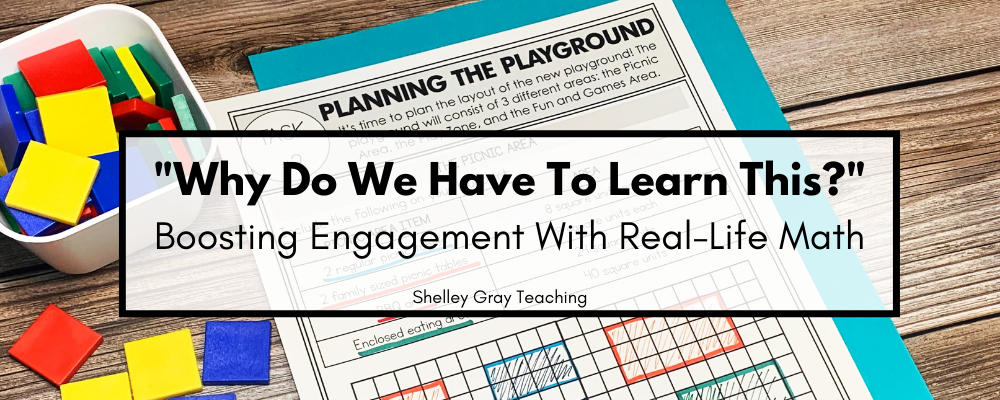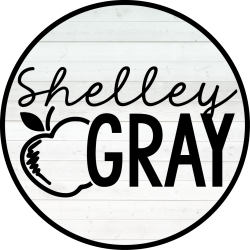
Do your students ask, “Why are we learning this?” or “When will I ever use this?” Real-life math projects answer these questions by allowing students to work with meaningful, relevant situations that they might encounter in real life. The projects are high-interest and use math to complete a variety of relevant tasks and problem solve. Many projects will have open-ended questions resulting in answers that vary based on the student and the situation. Getting a “right answer” or solving a problem a certain way isn’t as important as working together, explaining your thinking, and using math concepts to tackle a larger problem.
“My students really loved this project. They could easily see the real-world application and I liked that I could get so much assessment information from it. It really made the material applicable to my students’ experiences in the real world which kept them engaged and interested in learning. Thanks for a great resource.” -Katie L.

How do I Choose a Real-Life Math Project?
So you’ve decided to give real-life math projects a try. Where do you start? How do you choose the right project? First, think about your students. What are their interests? For example, maybe your students are really into graphic novels or superheroes. Maybe your students have recently written animal reports and have taken a field trip to a zoo.
Also consider the math skills that need to be reinforced. Do you want them to work on basic multiplication facts, geometry concepts, or understanding fractions? Knowing your students’ interests and the math skills required will help guide you to the ideal project. Math projects also give you the opportunity to differentiate to students based on interests and needs. While one student may be working on multi-digit operations in Create a Dinosaur Park, another may be working on basic multiplication in Design a Playground.
Related: Get inspired with a variety of ready-to-go projects for a variety of grade levels .
How Do I Implement a Real-Life Math Project?
Although some teachers use math projects to facilitate classroom transformations, that is not required to engage your students! But remember – the more excited you are, the more eager your students will be! Here are some practical tips to get started:
Brainstorm – After choosing a project, give students a general overview and let them think of ideas and then share with a partner or the class. If your students are working on the Design a Playground project, let them draw or share all their ideas about what it should look like and what types of playground equipment should be included.

Set Clear Expectations – Let students know who they will be working with and what makes their work time on this project successful. For example, you may choose to focus on listening to group members, explaining mathematical thinking, and staying on task.

“This unit was a real hit with my grade 4 class. Students were totally engaged, even those who don’t typically like math all that much. What a great way of putting real-world perspectives into math in a relatable way for students. They loved it! Thank you!” – Andreana G.
Embrace the Struggle – If students are working in small groups, step back and allow them to try things out on their own within their groups. Support students with practicing positive group behaviors, but give students space to struggle with the math concepts. Ask questions like, “Can you explain your thinking?” or “Can you show your group how you came up with that answer?” to help students reflect on the strategies they are using.

Presentations – Make sure to celebrate successes at the end of projects by providing students the opportunity to share what they designed, learned, or accomplished during their project.
Assessments – Many teachers like to use math projects as an opportunity for assessment. This can be assessment during learning (formative) in order to drive instruction, or assessment after learning (summative) to wrap up a unit. Guided math groups are a great opportunity to work with specific tasks from projects in order to assess specific skills in a non-intimidating way.
“My students worked in pairs to complete this and with each page, their excitement grew! They loved putting their multiplication understanding to the test and enjoyed the challenge that his activity offered them. I cannot wait to use it with my students this year!” – Cortney S.

Extending the Learning with Mini Classroom Transformations
Math projects make fantastic mini classroom transformations – and you don’t have to spend hours and hours to put them together for your students! Here are some ideas I’ve heard from other teachers:
- Bring stuffed animals into the room and set up stations to work on the Run a Pet Shelter Project.
- Invite a local animal shelter to do a presentation. (Also used for Run a Pet Shelter.)
- For the Run a Pizza Place project, put checkered table cloths at math centers around the room. Have a pizza box at each station with the activity they’ll work on at that station. Have a real pizza party when students are finished the project!
- Have a coffee taste-test for the Run a Coffee Shop project (or let kids drink hot chocolate out of coffee cups as they work).
- Set up tents in the classroom for the Camping Trip math project. Or turn off the lights and have lanterns and flashlights available! Make s’mores as a wrap-up activity!
- Use the Run a Candy Store project to inspire a real-life candy store inside the classroom!

Where Can I Find Ready-to-Go Real-Life Math Projects For My Students?
If you are looking for ready-made, no-prep math projects for your classroom, there are over 40 projects available for a variety of grade levels. Grade level bundles are also available. Use the links below to find out more!
Or see bundles here:
Grade 2-3 Math Project and Escape Room Bundle







